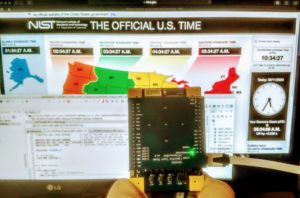Here is an example of running a timer on the LPC804, originally written in C and then modified to work in C++14 on MCUXpresso 11.1.
Here we're using the 1MHz Low Power Oscillator to drive the Wakeup Timer on the LPC804. The same code would work as a C++ project on the LPC802 (OM40000 board) if we swapped out the LPC804.h header for LPC802.h. As well, LED_USER1 (20) would have to be LED_USER1 (9) since there are different GPIO connections to LEDs on the OM40000 (LPC802) board versus the OM400001 (LPC804) board.
To adjust the frequency, modify the WKT_RELOAD value. Note that this adjusts the interrupt request frequency. The actual LED flashing frequency will always be half that because the interrupt service routine (function) uses a toggle ("NOT") that has to run twice to make the LED blink completely.
// LPC804_Project_WKT_CPP14.c // // based on NXP sample code. // // ----------------------------------------------- #define WKT_FREQ 1000000 // Use if the WKT is clocked by the Low PWR Oscillator //#define WKT_FREQ 937500 // Use if the WKT is clocked by the 15 MHz FRO, // via the div-by-16 WKT divider #define WKT_RELOAD 500000 // Reload value for the WKT down counter #define WKT_INT_FREQ (WKT_FREQ/WKT_RELOAD) // Interrupt frequency of the WKT. #define LED_USER1 (20) // GPIO #20 (PIO0_20) is connected to the LED #include "LPC804.h" // prototypes void WKT_Config(); // main routine // int main(void) { // WKT: Wake Timer configuration WKT_Config(); // do nothing in the main loop. while(1) { asm("NOP"); } // end of loop. } // end of main // Function name: WKT_Config // Description: Initialize a GPIO output pin and the WKT, then start it. // Parameters: None // Returns: Void // Source: Ch. 18 of the User Manual (UM11045) void WKT_Config(void) { // ----------------------------------------------------- // Step 1. Make an LED turn on. Checks that board is up and running. // Enable GPIO for the LED. SYSCON->SYSAHBCLKCTRL0 |= (SYSCON_SYSAHBCLKCTRL0_GPIO0_MASK); // GPIO to Output. GPIO->DIRSET[0] = (1UL<<LED_USER1); // Turn on the LED. GPIO->CLR[0] = (1UL<<LED_USER1); // -------------------------------------------------------- // Step 2: turn on the Wake-up Timer (WKT) enabling clock. SYSCON->SYSAHBCLKCTRL0 |= (SYSCON_SYSAHBCLKCTRL0_WKT_MASK); // -------------------------------------------------------- // Step 3: disable the vector lookup for WKT. NVIC_DisableIRQ(WKT_IRQn); // turn off the WKT interrupt. // -------------------------------------------------------- // Step 4: Turn on the Low Power Oscillator's power supply. // bit 6 to 0 in order to turn it ON. (Active low) SYSCON->PDRUNCFG &= ~(SYSCON_PDRUNCFG_LPOSC_PD_MASK); // ---------------------------------------------------- // Step 5: Enable the LPOSC clock to the WKT. (Bit 1 to 1) SYSCON->LPOSCCLKEN |= (SYSCON_LPOSCCLKEN_WKT_MASK); // -------------------------------------------------------- // Step 6: Reset the WKT. // Set bit 9 to 0: assert (i.e. "make") the WKT reset // Set bit 9 to 1: clear the WKT reset (i.e. "remove" reset) SYSCON->PRESETCTRL0 &= ~(SYSCON_PRESETCTRL0_WKT_RST_N_MASK); // Reset the WKT SYSCON->PRESETCTRL0 |= (SYSCON_PRESETCTRL0_WKT_RST_N_MASK);// clear the reset. // ------------------------------------------------------- // Step 7: Load the timer // -------------------------------------------------------- // Select the LPOSC as the WKT clock source (0b0001) // Bit 0 (CLKSEL) to 1 for Low Power Clock // Bit 1 (ALARMFLAG) read flag. If 1, an interrupt has happened. if 0, then no timeout. // Bit 2 (CLEARCTR). Set to 1 to clear the counter. // Bit 3 (SEL_EXTCLK). Set to 0 for internal clock source. WKT->CTRL = WKT_CTRL_CLKSEL_MASK; // (Choose Low Power Clock using Bit 0) // load the timer count-down value. (The "Timeout value") WKT->COUNT = WKT_RELOAD;// Start WKT, counts down from WKT_RELOAD and then interrupt // Enable the IRQ NVIC_EnableIRQ(WKT_IRQn); // Enable the WKT interrupt in the NVIC } // Function name: WKT_IRQHandler (interrupt service routine) // Description: WKT interrupt service routine. // Toggles an LED & restarts the WKT. // Parameters: None // Returns: Void extern "C" // wrap in an extern for C++ { void WKT_IRQHandler(void) { WKT->CTRL |= WKT_CTRL_ALARMFLAG_MASK; // Clear the interrupt flag WKT->COUNT = WKT_RELOAD; // Restart the WKT (fill it again) // Toggle the LED GPIO->NOT[0] = (1UL<<LED_USER1); return; // return nothing. } }

